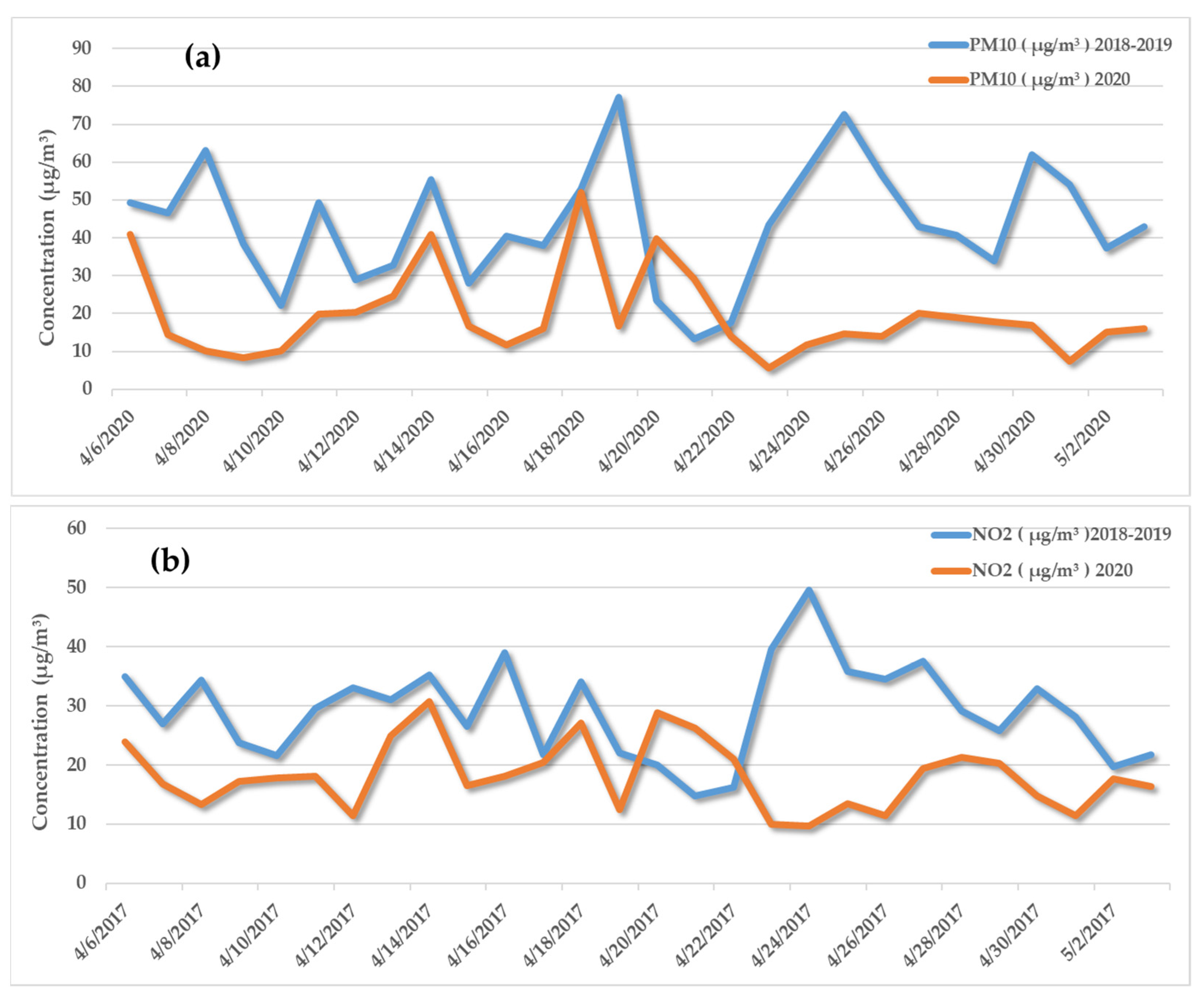Overview of Air Quality in Konya during COVID-19 Lockdown Periods †
Abstract
:1. Introduction
2. Materials and Methods
3. Results and Discussion
4. Conclusions
Funding
Institutional Review Board Statement
Informed Consent Statement
Data Availability Statement
Acknowledgments
Conflicts of Interest
References
- World Health Organization. Air Pollution. Available online: https://www.who.int/health-topics/air-pollution#tab=tab_2 (accessed on 3 January 2021).
- United States Environmental Protection Agency. Criteria Air Pollutants. Available online: https://www.epa.gov/criteria-air-pollutants (accessed on 3 January 2021).
- European Environment Agency. Air Pollution. Available online: https://www.eea.europa.eu/tr/themes/air/intro (accessed on 2 January 2021).
- European Environment Agency. Air Pollution Goes down as Europe Takes Hard Measures to Combat Coronavirus. Available online: https://www.eea.europa.eu/highlights/air-pollution-goes-down-as (accessed on 4 January 2021).
- Sharma, S.; Zhang, M.; Gao, J.; Zhang, H.; Kota, S.H. Effect of restricted emissions during COVID-19 on air quality in India. Sci. Total Environ. 2020, 728, 138878. [Google Scholar] [CrossRef] [PubMed]
- Berman, J.D.; Ebisu, K. Changes in US air pollution during the COVID-19 pandemic. Sci. Total Environ. 2020, 739, 139864. [Google Scholar] [CrossRef] [PubMed]
- Hashim, B.M.; Al-Naseri, S.K.; Al-Maliki, A.; Al-Ansari, N. Impact of COVID-19 lockdown on NO2, O3, PM2.5 and PM10 concentrations and assessing air quality changes in Baghdad, Iraq. Sci. Total Environ. 2020, 754, 141978. [Google Scholar] [CrossRef] [PubMed]
- Otmani, A.; Benchrif, A.; Tahri, M.; Bounakhla, M.; El Bouch, M.; Krombi, M.H. Impact of COVID-19 lockdown on PM10, SO2 and NO2 concentrations in Salé City (Morocco). Sci. Total Environ. 2020, 735, 139541. [Google Scholar] [CrossRef] [PubMed]

| Mean | STD | Difference in Historical and Current Means (% Change) | |
|---|---|---|---|
| PM10 (µg/m³) | |||
| Historical (2018–2019) | 43.6 | 15.1 | −24.2 (−55.7%) |
| Current (2020) | 19.4 | 11.1 | |
| NO2 (µg/m³) | |||
| Historical (2018–2019) | 29.3 | 7.9 | −11.1 (−37.7%) |
| Current (2020) | 18.2 | 5.7 |
Publisher’s Note: MDPI stays neutral with regard to jurisdictional claims in published maps and institutional affiliations. |
© 2021 by the author. Licensee MDPI, Basel, Switzerland. This article is an open access article distributed under the terms and conditions of the Creative Commons Attribution (CC BY) license (https://creativecommons.org/licenses/by/4.0/).
Share and Cite
Balcılar, İ. Overview of Air Quality in Konya during COVID-19 Lockdown Periods. Med. Sci. Forum 2021, 4, 28. https://doi.org/10.3390/ECERPH-3-09083
Balcılar İ. Overview of Air Quality in Konya during COVID-19 Lockdown Periods. Medical Sciences Forum. 2021; 4(1):28. https://doi.org/10.3390/ECERPH-3-09083
Chicago/Turabian StyleBalcılar, İlker. 2021. "Overview of Air Quality in Konya during COVID-19 Lockdown Periods" Medical Sciences Forum 4, no. 1: 28. https://doi.org/10.3390/ECERPH-3-09083
APA StyleBalcılar, İ. (2021). Overview of Air Quality in Konya during COVID-19 Lockdown Periods. Medical Sciences Forum, 4(1), 28. https://doi.org/10.3390/ECERPH-3-09083




